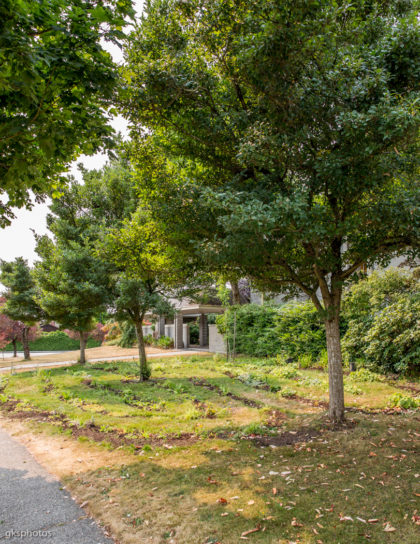Living Labyrinth Update August 2017

 Our living labyrinth has been very thirsty in recent days. Without water for nearly a week, I found that the thing about plants growing long roots when you don’t water regularly really is true. I moved a few calendula seedlings and their root was very long, reaching (unsuccessfully) for a drink.
Our living labyrinth has been very thirsty in recent days. Without water for nearly a week, I found that the thing about plants growing long roots when you don’t water regularly really is true. I moved a few calendula seedlings and their root was very long, reaching (unsuccessfully) for a drink.
Calendula
There are calendula at all stages from full bloom (and seeds) down to tiny sprouts. The name calendula is related to the word calendar. Timed right for planting and without a really cold winter, we should have calendula blooms all year ’round. Feel free to pick flowers and put in salads or make a massage oil. The more the flowers are picked, the more they put out.
Hardy Perennials
The cranesbill geranium are flourishing in this area. They’ve at least doubled since last year. As I was tending some areas that were crowded a few weeks ago, I accidentally dug up a few small pieces with roots and they seem to be taking hold, even though summer, especially a dry summer is not the best time for propagation.
The unusual flowers and stems on the lamb’s ears are past their prime, so I cut them back in several places.

Succulents
The low-growing sedum is spreading and has pink flowers in some spots. It seems its only problem is too much water, but it can tolerate even the clay soil we still have in various spots.
The Blue Spruce Sedum. has burst into flower in several spots and is faring well.
Sempervivum (hens and chicks) is doing well and spreading. I’m told they’ll spread on their own but you can also plant leaves to spread. I’ll try it and report back.
From reading about the differences between sempervivum and echeveria, I’ve concluded that the tall stalk with flower is sempervivum. They say the plant will die leaving the chicks to carry on. It seems likely the flowering which can be unusual was from the stress of poor soil and/or lack of water. Sempervivum is hardy through frost and echeveria not so much.
I’d love to have an even greater variety of succulents, as they’re perfect for the sunny, dry conditions, so if you have any that are spreading, please bring us some.
Perennial Grasses
Carex ice dance is doing well although some of the smaller plants have withered through lack of water. It would be nice to have some other perennial grasses. I prefer the ones that stay green all year.
Herbs
We have rosemary, sage and three new lavender plants (these on the farthest east circuit). The lavender was donated by a neighbour who had several in a window box and they outgrew their tiny home. Feel free to pinch a bit off to enjoy the scent as you walk. You may find a few chives and mint too, although they will likely be moved. If you want some chives or mint, just ask me though, as they’re spreading in the vegetable garden and I’d love to pass some along. There’s some garlic chives too.
Thyme
Around the central hawthorn tree is a growing blanket of woolly thyme. And on the boulevard Patti sprinkled some creeping thyme seeds a couple of years ago and even without any watering or weeding, they’re holding their own against the grass.
Primulas
The primulas are past their prime but are alive and well and resting for the season.
Self-seeding Annuals
There’s a variety of flowers that have self-seeded.
Spring Bulbs
We have tulip bulbs drying to plant in September and may divide up some of the snowdrops and grape hyacinths at that time. It’s a very hopeful and cheerful place once the spring bulbs of snowdrops, crocuses, daffodils, tulips and grape hyacinths burst through to wish us happy spring.
Fall Bulbs
We were given some fall bulbs that are planted on the south-eastern area. Hope to see them soon.
Strawberries
The strawberry plants didn’t get enough water to provide much in the way of fruit, but the foliage is quite nice and the ones planted last year are sending out runners. I’ll move some of the borage from the vegetable gardens as it’s recommended as a companion plant that attracts pollinators.
Falling Leaves
You can see that leaves are already dropping once August is here. The thin crunchy ones are great for the black compost bins as bedding for our worms. The thicker ones take a long time to decompose, so put those in the City’s green bins.
Soil Quality
Slowly the quality of the earth is improving as our red wriggler worms do their thing with the compost. Still in some areas the soil is very clay and water does not drain well.
About the Living Labyrinth

The living labyrinth is a double processional style and on the east side of the Unitarian property, adjacent to Fremlin. You can come any time to walk it alone or in a group.
Several church members have taken to walking it before church on Sundays as their meditation.
Want to help?
If you’d like to help tend the labyrinth, donate plants or just pull a few weeds, contact Mary Bennett. There’s much to be done, and you’d be very welcome to join our team, whether you’re involved in the church or not.
Photos by Gail Stephan.


